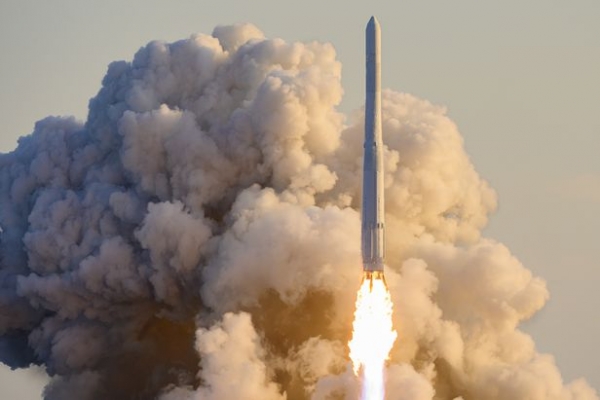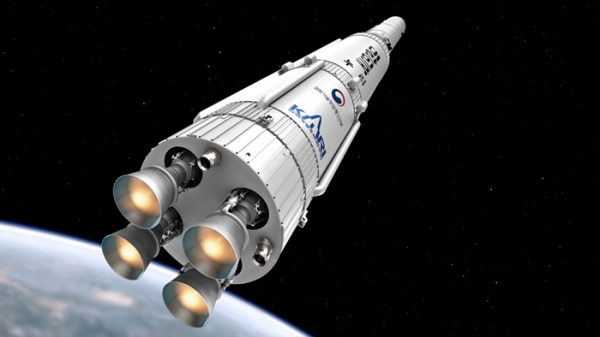
On Oct. 21, South Korea’s first homegrown launch vehicle KSLV-II (Korea Space Launch Vehicle II), commonly known as Nuri, was launched into space. The rocket seemed to go through a successful flight as it reached the target altitude of 700 kilometers, yet it failed to deliver the payload into orbit. However, the launch marked a milestone in South Korea’s aerospace history. Some experts suggested that the fact Nuri failed at its last step while completing prior stages could be considered as a huge success, given that less than 30 percent of the rockets in the world succeeded on their first launch. The second launch is scheduled to proceed next year in May.
What is Nuri?
Nuri is South Korea’s first homegrown launch vehicle developed by the Korea Aerospace Research Institute (KARI). It is a successor to KSLV-I or Naro-1, the first South Korean launch vehicle launched in 2013. Nuri aimed to carry a 1.5-ton utility satellite into the low Earth orbit (LEO), which is located 600 km ~ 800 km from Earth. The development of Nuri began in 2010 under the South Korean government, which has provided total funding of 1.9572 trillion KRW.
Design and Structure
Nuri is a three-stage launch vehicle with a height of 4.72 meters and a width of 3.5 meters. Three-stage means that the vehicle consists of three different rocket parts that are jettisoned after each of them runs out of propellants. This allows for the more efficient propulsion of the vehicle to reach its attempted speed or height. The lowest part of the stage is the first stage, or stage 1, and the upper stages with lower sizes and weights are successively placed above one another.
The first stage of Nuri consists of four 75-ton liquid engines (KRE-075) clustered together with each having a thrust of 735 kN. The second stage consists of a 75-ton liquid engine and the third stage consists of a seven-ton liquid engine (KRE-007). All engines make use of kerosene as fuel and liquid oxygen and jet fuel as oxidizing agents. Kerosene has less volatility but a greater boiling point than gasoline that leads to greater accessibility, and it is also relatively cheap and eco-friendly. Liquid oxygen, instead of gas-phase oxygen, is used as an oxidizing agent to decrease the weight and volume of the storage. It is noted that one kilogram of atmospheric gas-phase oxygen requires 750 liters of storage while the same amount of liquid oxygen only requires 0.876 liters of storage. The propellants are stored in a tank made of light and durable aluminum alloy to keep them at optimal temperatures.
Although there are slight differences in burn time, thrust, or size, both the 75-ton and seven-ton liquid engines of Nuri use the same technique called turbopump-based gas generator open cycle (GG open cycle) to create thrust. The principle of the rocket engine lies in the upward force created by the pressure from fuel combustion. However, this pressure also forces the fuel back into the rocket that may cause malfunction, so extra pressure must be applied on the rocket to prevent it. To do so, the engines of Nuri make use of turbopumps and an open cycle. Here, a proportion of propellant used in the engine is removed and supplied to the gas generator to produce gas to be used in the turbopump, and the used gases are emitted through a small pipe.
Development Process
The development of Nuri was largely planned based on three phases. In the first phase (March 2010 ~ July 2015), the construction of liquid engine testing facilities and a seven-ton engine was planned. In the second phase (Aug. 2015 ~ Feb. 2019), the final assembly of all engines and the testing of a two-phase test launch vehicle (TLV) were planned. In the third phase (April 2018 ~ May 2022), the clustering of 75-ton engines and the two final launches of the vehicle were planned.
The first seven-ton engine combustion test was completed in March 2014, and the combustion test of the 75-ton engine reached its targeted burning time of 145 seconds on July 20, 2016. Then the TLV, whose main objective on the test launch was to check the qualification of the 75-ton engines, was successfully launched in Nov. 2018. Afterward, the construction of three-stage Nuri began with the clustering of 75-ton liquid engines with the first launch planned for this February and the second launch planned for May 2022. However, due to the defects discovered, the first launch was delayed to Oct. 21. The final check stage for launching called the wet dress rehearsal (WDR) was completed on Aug. 27.
Significance
Nuri is South Korea’s first indigenously developed launch vehicle. Its predecessor Naro-1 was built in conjunction with Russia, so there had been some skepticism that South Korea still did not have the capable technologies to build their own launch vehicle. Thanks to Nuri, however, South Korea has become the seventh country in the world to possess homegrown space vehicle technology. As Nuri overcomes its shortcomings and succeeds in its second launch, South Korea will be able to innovate in the space industry and grow as a space power in the future.



